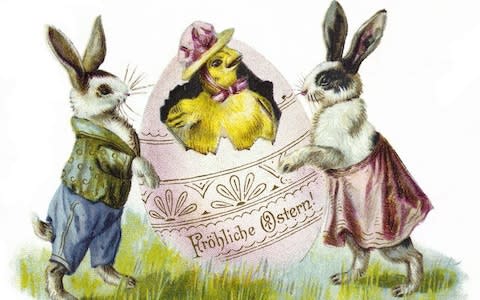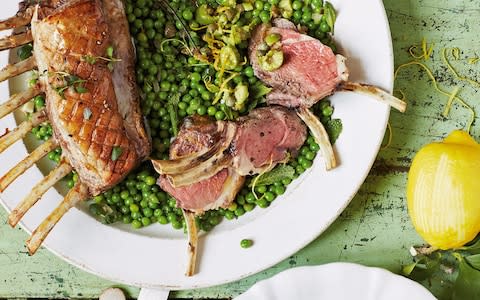Easter 2019: Forbidden eggs, Eostre and how the date is decided

Easter weekend is fast approaching with all the fondant-filled Creme Eggs, sticky hot cross buns and sugar-coated Mini Eggs our stretchiest waistbands can withstand.
Of course, the Christian festival is far more than its associated confectionery.
Easter celebrates the resurrection of Jesus Christ who, according to the New Testament, died on the cross on Good Friday and came back to life three days later. His resurrection is celebrated on Easter Sunday, which also marks the end of Lent's 40-day period of fasting.
From the origins of the Easter bunny to the celebrations' ever-changing dates, here is your essential guide to the holiday.
When is Easter 2019?
This year, Good Friday falls on April 19, Easter Sunday on April 21 and Easter Monday on April 22 - three weeks later than they did last year.
While the holiday is a movable feast, it always falls somewhere between March 21 and April 25 every year. It is calculated as the first Sunday after the first full moon following the first day of spring. The full moon is known as the Paschal (Passover) Full Moon.
Methods for calculating Easter are fiendishly complicated and a uniquely baffling synthesis of mathematics, astronomy and theology.
As Christians believe Jesus was crucified during the Jewish Passover festival, Easter is celebrated around the same time. Nonetheless, different Christian groups were already marking it on separate dates by the end of the 2nd Century.

These date-led disagreements even set the course of history for the British Isles at the Synod of Whitby in 664AD when the preferred date of the Roman - rather than the Celtic - church became the standard. The decision is said to have catapulted Britain into the European sphere of influence.
Though disputes over Easter's exact timing have been used as proxies for deeper power struggles for centuries, most now accept that it falls on the first Sunday following the first full moon after the spring equinox - which the Church approximated as March 21.
This year, Easter Sunday falls on April 21, the longest stretch following March 21's full moon – which falls on a Sunday.
In 2016, the Archbishop of Canterbury suggested Easter should fall on the same Sunday every year and the Most Rev Justin Welby said Anglican leaders would join discussions with other church leaders to fix the date for the first time, theoretically putting an end to almost 2,000 years of controversy.
What do eggs have to do with Easter?
Eggs illustrate new life, just as Jesus began his new life on Easter Sunday after the miracle of his resurrection. When eggs are cracked open they are said to symbolise an empty tomb.
Originally, eating eggs was forbidden in the week leading up to Easter (known as Holy Week). They were saved and decorated in the run-up to the celebration and given to children as gifts.
Sometimes they were coloured red, in recognition of the blood sacrificed by Jesus when he was crucified. Green was also used to symbolise spring re-growth after the winter.
The first chocolate eggs appeared in France and Germany during the 19th century. As chocolate-making techniques improved, the Easter egg as we know it was popularised.
Where does the Easter Bunny fit in to all of this?
Rabbits and hares have been associated with spring for hundreds of years. It is thought that the Anglo-Saxon Goddess of Spring, Eostre – who many believe the Christian event is named after – had a hare as her companion, symbolising fertility and rebirth.
It’s hardly surprising that rabbits and hares have become associated with fertility as they are both prolific breeders and regularly give birth to large litters in early spring.
The legend of the Easter Bunny is thought to have originated among German Lutherans, where the ‘Easter Hare’ judged whether children had been good or bad in the run-up to Easter.

Over time it has been incorporated into Christian celebrations, becoming especially popular in Britain during the 19th century.
Many children believe that the Easter Bunny lays and hides baskets of coloured eggs, sweets and toys in their homes or around the garden the night before Easter Sunday – much like Father Christmas delivering gifts on Christmas Eve.
This has given rise to the tradition of the Easter egg hunt which is still popular among children today.
Why do we eat hot cross buns?
A hot cross bun is a spiced, sweet bun marked with a cross on top. They are traditionally eaten on Good Friday as the cross represents the crucifixion of Jesus, while the spices are said to remind Christians of the spices put on his body.
Hot cross buns appeared in the Oxford English Dictionary in 1733 but they are believed to have existed long before.
Enriched, sweetened bread dough dates back to the Romans. Long before Christianity, loaves and buns were baked with symbols on them, one of which was a cross.
Small, spiced cakes were also baked to honour the Saxon goddess Eoestre and celebrate spring, but it was the Tudors who began to link the spiced currant buns we know today with feast days, celebrations and - eventually - Lent.
Delicious recipes to cook this Easter

Jose Pizarro's roast rack of lamb with braised peas and lemon-thyme salsa


Paul Hollywood's Easter simnel cake

How is Easter celebrated around the world?
In many central and eastern European countries decorating eggs with beautiful patterns is especially popular.
In Switzerland, Easter eggs are delivered by a cuckoo and, in some areas of Germany, a fox.
The egg-giving tradition arrived in the United States in the 18th century via protestant German immigrants in the Pennsylvania Dutch area.
On Easter Monday, the President of the United States holds an annual Easter egg roll on the lawn of the White House for young children.
In the Republic of Ireland and Northern Ireland it is a day of remembrance for the men and women who died in the Easter Rising which began on Easter Monday 1916.

 Yahoo News
Yahoo News 
